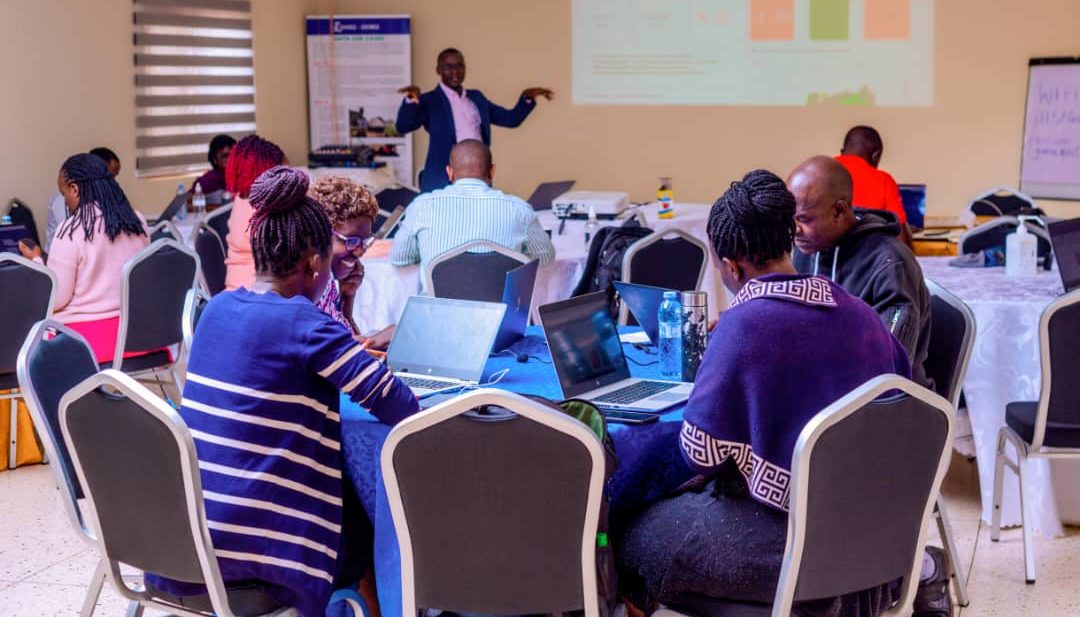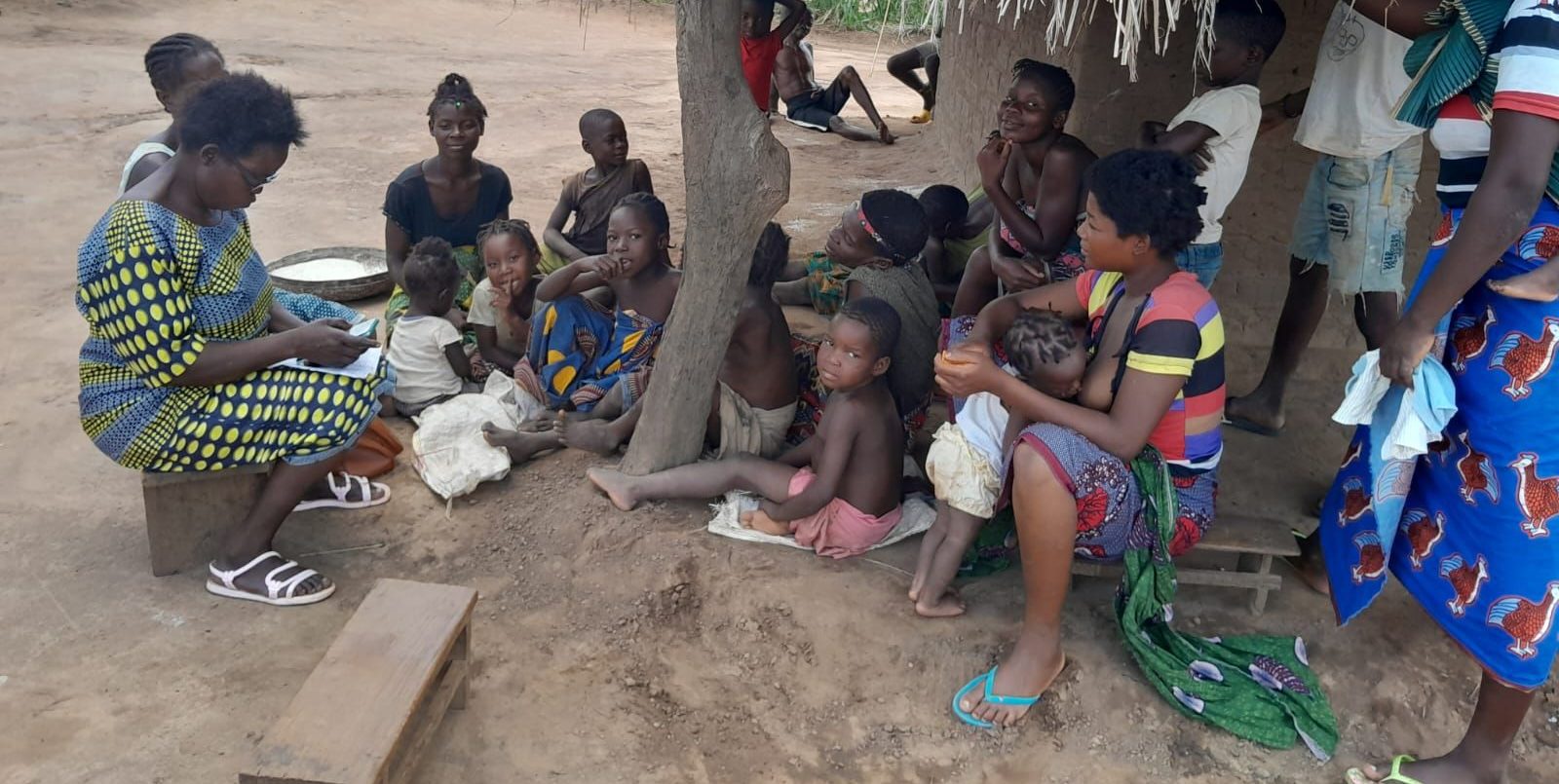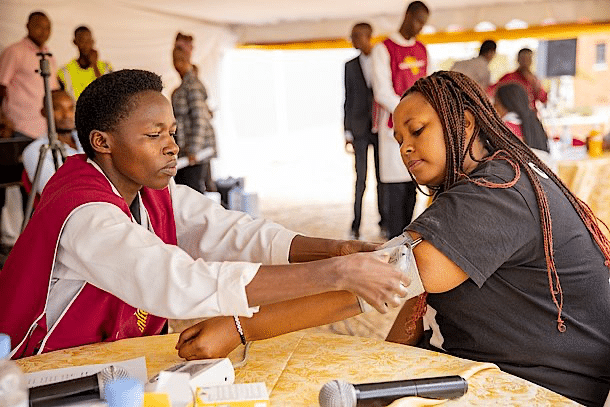Cette page a été traduite automatiquement et pourrait contenir des erreurs
Suivi des patientes atteintes d’un cancer du sein au Pérou avec DHIS2
PATH, EHAS et le ministère régional de la santé de Trujillo, au Pérou, ont collaboré à la conception et à la mise-en-œvre d’un registre électronique du cancer du sein afin de faciliter le suivi des patients en temps réel.
Le cancer du sein est le cancer le plus fréquent chez les femmes au Pérou, avec un taux de mortalité élevé. Depuis 2016, PATH a mis à l’échelle un modèle de détection du cancer du sein à Trujillo, au Pérou, en partenariat avec le ministère régional de la Santé. Le modèle comprend l’examen clinique des seins (ECS), le triage par ultrasons (TU) et la biopsie par aspiration à l’aiguille fine (AAF). Jusqu’au milieu de l’année 2020, ces opérations étaient effectuées à l’aide de formulaires cliniques sur papier.
Trujillo compte plus de 900 000 habitants. Avec environ 6 000 femmes par an, âgées de 40 à 69 ans, suivies par le ministère régional de la santé pour un cancer du sein, la capacité d’assurer un suivi adéquat des patients à l’aide de formulaires papier était limitée. Parmi les défis spécifiques identifiés, on peut citer
- Absence de système numérique pour le suivi des visites de dépistage du cancer du sein, de l’examen clinique des seins (ECS) au niveau primaire, au triage par échographie, à la biopsie par FNA (niveau secondaire), au diagnostic et enfin au traitement (niveau tertiaire).
- Système d’orientation faible, basé sur le papier, pour le suivi des patients et le diagnostic lorsqu’une femme a été orientée avec un CBE anormal.
- Les prestataires de soins de santé de niveau primaire et secondaire ne connaissaient pas les résultats du diagnostic de cancer ou les plans de traitement pour leurs patients référés comme hautement suspects de cancer.
- Absence de système numérique permettant de calculer le temps écoulé entre la première visite de dépistage et le diagnostic final.
Pour y remédier, le ministère de la santé, PATH et Enlace Hispano Americano de Salud (EHAS) ont lancé début 2020 une mise-en-œvre pilote d’un registre électronique du cancer du sein à Trujillo à l’aide de Tracker DHIS2.

Conception d’un programme Tracker pour le suivi en temps réel des cas suspects de cancer du sein à travers toutes les étapes du diagnostic et des soins.
L’objectif du projet pilote à Trujillo était de mettre en œuvre une approche numérisée qui permettrait aux agents de santé de suivre les patients individuels – y compris leurs résultats de diagnostic, les références et les soins reçus – à travers les trois niveaux de soins de santé pour les activités de détection du cancer du sein, avec des rapports générés à chaque niveau jusqu’à l’Institut régional de cancérologie (IREN Norte). L’équipe a choisi l’application DHIS2 Tracker pour les données basées sur les cas afin de collecter, gérer et analyser ces informations. Alors que le DHIS2 est actuellement utilisé comme registre électronique pour divers programmes de santé dans le monde, il existe peu d’exemples de Tracker utilisé spécifiquement comme registre du cancer. Grâce à la nature flexible de la plateforme DHIS2, PATH, EHAS et le ministère de la santé ont pu créer un programme Tracker paramétré, adapté à leur cas d’utilisation et à leur flux de travail.
Tout d’abord, les données sur les femmes recevant un ECS au niveau des soins de santé primaires sont collectées et saisies dans Tracker, en utilisant soit le portail DHIS2 basé sur le web sur des ordinateurs portables, soit l’application Saisie Tracker Android de DHIS2 sur des tablettes dans les cliniques qui ne disposent pas de connexions internet stables. Les femmes dont les résultats de l’ECS sont positifs sont orientées vers l’UT. Si nécessaire, une biopsie FNA est réalisée. En cas de suspicion de cancer, la femme est orientée vers l’institut régional de cancérologie pour confirmation du diagnostic et mise en place du traitement. Tout au long de ce processus, DHIS2 veille à ce que les informations relatives au diagnostic, au traitement et à l’orientation de la patiente soient disponibles électroniquement à chaque niveau, et fournit un retour d’information aux agents de santé sur les femmes qui ont besoin d’un suivi. Le système crée également des rapports sur le nombre total d’ECB effectués, les ECB anormaux, les TU, les FNA, le diagnostic de cancer et l’initiation du traitement, collectivement et individuellement, par établissement de santé. Ces rapports aident les responsables de la santé à suivre les performances globales du programme de lutte contre le cancer du sein, tandis que les outils d’analyse intégrés à DHIS2 leur permettent d’analyser les statistiques relatives au dépistage et au diagnostic du cancer.
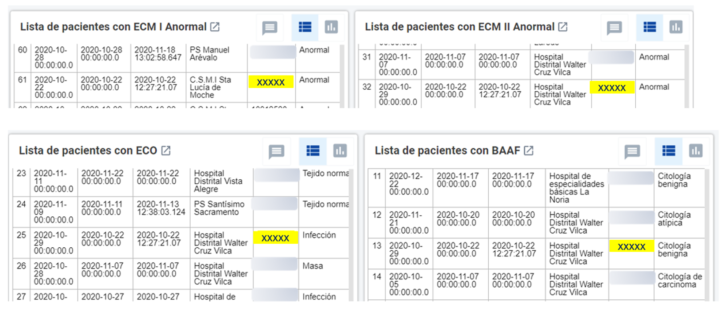
Collaborer à la conception, à la mise-en-œvre et au renforcement des capacités pour soutenir l’appropriation du système local en vue d’une durabilité à long terme.
La conception globale du projet pilote et du système DHIS2 Tracker a été réalisée en étroite collaboration entre PATH, EHAS et le ministère de la santé de Trujillo. Tout d’abord, les 14 établissements de santé qui ont participé au projet pilote ont été sélectionnés sur la base de critères tels que la présence d’un personnel formé à l’utilisation de l’EBC et de compétences informatiques. L’équipe s’est ensuite réunie pour déterminer les indicateurs et les variables à inclure dans le système. Des routeurs, des tablettes et des ordinateurs portables ainsi que d’autres matériels de réseau ont été fournis aux établissements de santé pour améliorer l’accès à l’internet. Un professionnel de l’informatique a été engagé pour apporter son soutien et l’hébergement de l’instance DHIS2 a été organisé.

Une fois le système configuré, l’équipe a commencé la formation des utilisateurs. Le début de la pandémie de COVID-19 en mars 2020 a obligé l’équipe à passer d’un renforcement de capacités en présentiel à un renforcement de capacités virtuel. La première formation de cinq jours a eu lieu en juillet 2020, sous la direction de l’équipe espagnole de l’EHAS. Cette formation était destinée aux coordinateurs du ministère de la santé et de PATH au niveau régional, qui serviraient de point de contact pour les utilisateurs locaux. La formation des utilisateurs finaux pour les travailleurs de la santé (médecins et sages-femmes), y compris ceux qui effectuent l’ECS, l’UT et la FNA, a été réalisée en ligne en octobre 2020. Après une validation finale de la conception du système, la saisie des données a commencé dans les 14 établissements de santé fin octobre 2020.
Au cours des premiers mois du projet pilote, les utilisateurs finaux ont bénéficié d’une assistance professionnelle pour résoudre les questions ou les problèmes qui se posaient. Un groupe WhatsApp a également été créé pour répondre aux questions de l’ensemble de l’équipe pilote. Après cette période initiale de renforcement des capacités, la propriété du système a été transférée au ministère régional de la santé, car l’intégration du registre du cancer DHIS2 dans l’administration régionale de la santé publique le rendra plus durable au fil du temps.
Le projet pilote de Trujillo obtient des résultats prometteurs et contribue à ouvrir de nouvelles perspectives pour le DHIS2 en tant que registre du cancer et à étendre l’utilisation du DHIS2 en Amérique latine.
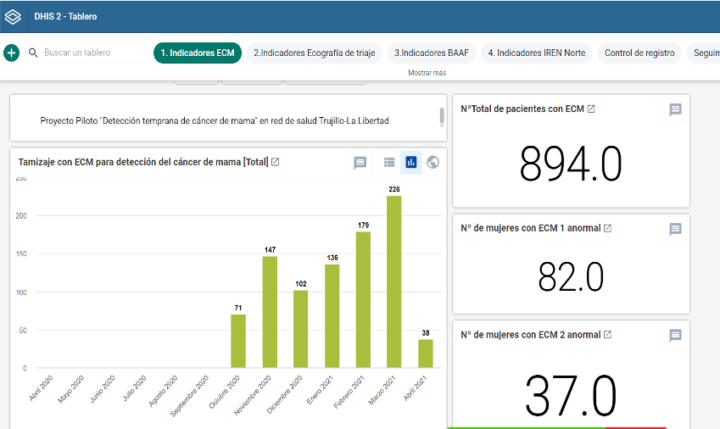
Le lancement pilote d’un registre électronique du cancer du sein à Trujillo a atteint ses objectifs. Le ministère régional de la santé a réussi à mettre-en-œvre un registre électronique du cancer du sein utilisant le DHIS2 dans 14 établissements de santé et l’IREN Nord, et a formé 25 professionnels de la santé et des technologies de l’information à l’utilisation du système. En juin 2021, plus de 1 000 femmes avaient été enregistrées dans le système DHIS2 et les agents de santé effectuaient un suivi en temps réel du processus de soins en cas de résultats anormaux de l’ECS. Sur les 41 résultats anormaux de l’ECS enregistrés, les médecins ont effectué 35 TU et 17 FNA ont été réalisées par la suite, ce qui a permis de détecter un cancer du sein chez 6 patientes. Les coordinateurs de cancérologie et les prestataires de soins de santé de Trujillo ont été très satisfaits de la facilité avec laquelle ils pouvaient suivre le traitement de leurs patientes à tous les niveaux du processus du cancer du sein grâce au DHIS2. Fortes du succès de ce projet pilote, les autorités sanitaires régionales péruviennes se sont engagées à assurer la durabilité de cette plateforme numérique et espèrent étendre leur registre DHIS2 au cancer du col de l’utérus, ainsi que déployer le système dans les autres cliniques et hôpitaux de la région.
Ce projet pilote était unique pour deux raisons : Au moment où il a débuté, peu de pays d’Amérique latine avaient développé et mis en œuvre des systèmes DHIS2 en espagnol, et aucun autre système dans la région n’était spécifiquement axé sur le suivi du cancer du sein. L’équipe du projet a constaté que DHIS2 Tracker et l’application Saisie Android de DHIS2 étaient des outils conviviaux qui permettaient au système de santé publique de Trujillo de suivre plus facilement les femmes tout au long de leur parcours de détection du cancer du sein. L’HISP UiO remercie PATH, EHAS et le ministère de la santé de Trujillo d’avoir partagé les détails de leur travail avec la communauté DHIS2 mondiale, et espère que d’autres systèmes de santé pourront bénéficier de leur exemple lors du déploiement de DHIS2 en tant que registre électronique pour le cancer ou d’autres maladies non transmissibles, et que d’autres pays d’Amérique latine pourront bénéficier de l’expérience DHIS2 de l’équipe du Pérou.
Pour en savoir plus sur ce projet, consultez le site web de PATH et regardez une présentation vidéo du travail de l’équipe de Trujillo lors de la conférence annuelle DHIS2 de 2021 :
